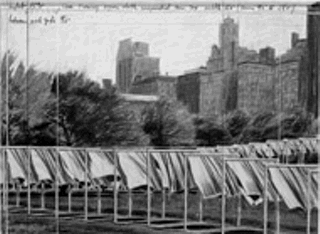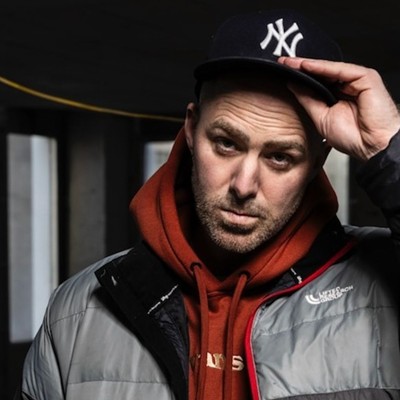Last February when artist team Christo and Jeanne-Claude cloaked New York’s Central Park with 7,503 saffron panels, created from 99,155 square metres of woven fabric, they accomplished much more than an awe-inspiring installation of public art in one of the world’s most famous landmarks. Their work, formally titled “The Gates, Central Park, New York, 1979-2005,” actually brought visual art into public discussion. For a nano-second, watercooler chats about Britney Spears’ pregnant hankering for Cheetos and speculation over Brad Pitt’s divorce dropped off, as international media focused their attention—both negative and positive—on the aesthetic merits of Christo and Jeanne-Claude’s incredible achievement.
The Art Gallery of Nova Scotia hopes this collective fascination with Christo and Jeanne-Claude and “The Gates” is strong enough to draw a crowd to its latest exhibition, Christo and Jeanne-Claude: The Würth Collection. Opening August 11, the travelling show (organized by Washington’s Trust for Museum Exhibitions) is comprised of 80 large-scale photographs, drawings, models and collages of the duo’s fabric works. Although some visitors will be drawn to photos of “The Gates,” perhaps the most exciting work in the show is a series of drawings of their next ambitious project: to cover the Arkansas River in Colorado with 10.7 kilometres of luminous fabric panels.
The city’s minor brush with artistic fame brings up some interesting questions about Halifax’s relationship with public art. If Christo and Jeanne-Claude wanted to temporarily wrap Citadel Hill, would city council and public opinion send them packing? Would they be given the freedom to dazzle and surprise us, or would layers of bureaucratic consultation and restrictions dilute the artistic experience? After all, it took almost 30 years and a signed 43-page contract to convince New York of the worthiness of “The Gates.”
While it’s unlikely Christo and Jeanne-Claude will appear here with swatches in hand, it’s an excellent time to open up discussions about public art and its place in our city. We already have some great examples, both permanent and temporary: NSCAD University’s resurrected stone lions in Granville Mall, Eye Level Gallery’s billboards on Gottingen and the student exhibition in front of Dalhousie’s School of Architecture and Planning on Spring Garden.
Still, the more we talk about art, the stronger our defenses become against “plop art”—those unattractive, inappropriate pieces of public art, often found in front of office buildings and parks.
Marion Currie is a Capital District project coordinator for HRM. She is also the gatekeeper for a new sculpture that will greet visitors in front of the Halifax North Memorial Public Library on Gottingen. She says the history of the sculpture goes back to 2003, when the city had public consultations and learned that the community overwhelmingly wanted to replace an old piece that was removed from the spot because of safety issues. Twenty-five to 30 people attended a second meeting, held earlier this year, to develop a broad theme for the artists’ call.
“The community stated loudly and clearly that it wanted its diversity reflected in the new piece to portray the strength of the community,” says Currie. “Rising from the ashes, to tie into the Halifax Explosion and the revitalization efforts that are happening there now.”
Although Currie says that this meeting was not meant to “tie the hands of the artists and say specifically what we want to see there,” according to artist Ilan Sandler, there’s a fine line in balancing public input and artistic vision. Sandler, whose temporary public installations draw on their surrounding environments—his work includes a bright-orange EKG heartbeat running alongside St. Louis’s train line, and a giant 5.5 metre steel lawnchair commissioned by Toronto’s outdoor Sculpture Garden—has witnessed both good and bad collaborations while working on a variety of projects across North America.
“When it’s done right, there is a real connection between the artist and the community,” he says. “Otherwise, you will just end up with plop art,”
Sandler believes community consultation is just one aspect of a successful project. Adequate research time, modeling and materials durability testing is just as critical. When Sandler heard the initial timeframe given for the Halifax Library project (the call for artists went out in May with the project to be completed by the end of the year), an “alarm bell went off” because of the short deadlines provided for research on the site and the community. “You need time to let the site respond in advance,” he explains. Although Sandler is assisting one of the short-listed artists, he decided not to put forward a proposal for himself.
Currie admits there was a learning process involved with the project: “Our initial desire was to have it in place before the snow starts falling. We were looking at the end of November but the arts community said to us that’s not realistic. And I’m a project coordinator, not an artist, so based on their recommendations, we changed the deadline to early spring.”
Currie relies on her five-person jury for guidance in such matters. Made up of representatives from Visual Arts Nova Scotia and Nations in a Circle, a NSCAD University instructor, an art teacher from St. Patrick’s-Alexandra School and a local community member, the group has selected four finalists from the nine artists who initially submitted proposals. The final four were chosen based on their resumes and experience in delivering projects of this size—there is a significant $95,000 budget allocated to the work. On August 17, the four will present models to the jury, with a decision expected by the end of the summer.
Ideally, Sandler says the city should have an experienced curator involved in overseeing these projects. It’s also important that public art development should be an arms-length operation, safe from the city’s bureaucratic mechanics. Right now there are some loose guidelines in place from the former city of Halifax, but not an official public art program that can be referenced.
“In terms of public art, we don’t have well-defined parameters for it at this time,” says Currie. “Capital District and Culture and Heritage work cooperatively to implement everything. We are operating now and creating public art, although at a slower pace than after the cultural plan is created.”
Ah yes, the much-anticipated cultural plan, the DaVinci Code that will unlock all of the riddles and confusion surrounding HRM’s long-term strategy for cultural development. Yet, come November, once the plan is implemented, the public art landscape might just look a little clearer.
As HRM’s Cultural Advisory Committee finishes the first phase of public consultation with its neighbourhood Cultural Cafes and industry workshops, one point is clear: citizens in both the city’s rural/suburban and urban areas indicated that public art and “civic enhancement” (green spaces, gardens and trails) are among its top priorities, along with arts facilities development and youth programs. Holly Richardson, the committee’s project coordinator, says that at every planning meeting “citizens expressed interest in how we use our public spaces. They portray them as important places to experience culture.”
In order to encourage cultural experiences in public spaces, many cities across North America have adopted “Percent for Art” programs, legislating that a percentage of the total construction costs for any new building or renovation project must be designated for the commission or purchase of artwork. Although there is no confirmation that HRM will create such a program, Richardson says the new public art program will cover details such as maintenance, jury and artist selection. In preparation for the plan’s launch, the Culture and Heritage department is currently conducting an inventory of all existing public works.
But what would happen if Christo and Jeanne-Claude came calling? “We certainly wouldn’t turn away any artist who was prepared to work with us. Although funding is always an issue, that will be an issue even after the policy is created,” says Currie. “We just have to be creative and move with trying to get those funds—there certainly is a strong desire through HRM to develop better public spaces.”
















